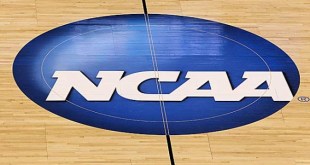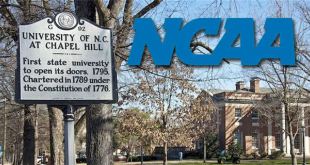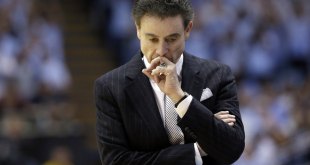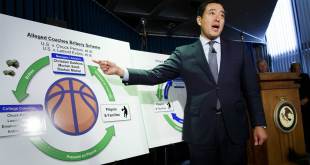As with the other current NCAA hot topics, transfers are making the news and causing outrage all over the place. We’ve talked about Peter Deppe’s lawsuit against the one-time transfer exception. You hear about situations where coaches/schools won’t release players, only to have what seems like media pressure force their hand. Then there are situations where schools won’t release a player amid allegations of improper recruiting, so the current school blocks the new school because, “screw them, that’s why.” Basketball transfers are seemingly at an all-time high, and with social media, these transfer decisions and bans on unpaid athletes come across as draconian non-compete clauses that even half of the business world doesn’t use. The NCAA, even more than amateurism, has a vice grip on lawsuits involving eligibility, so what is there to be done to reconcile some of the issues that transfer student-athletes face?
There are about 10 pages in the NCAA Manual on transfers (Bylaw 14.5). When is transfer status triggered, what do 2-4 (JUCO to NCAA four-year school) transfers have to do, what options are there for 4-4 (NCAA to NCAA school) transfers to be immediately eligible, what do 4-2-4 transfers have to do, and of course the graduate transfer rule. Most of these rules involve the same generic formula: if X, then the student-athlete doesn’t have to sit a year in residence and is eligible to play immediately; if not X, then academic year in residence at the new school. If 2-4 and 4-2-4 transfers meet academic requirements (and only academic requirements), they are eligible to play immediately. The real fun comes in with your standard 4-4 transfers switching between NCAA schools.
Several exceptions exist for immediate eligibility between four-year schools; however, many of them do not frequently come into play. If the sport is discontinued or not offered at the original school, if an academic program is discontinued, nonparticipants, and nonrecruited/walk-on student-athletes are all potential exceptions that allow for immediate eligibility. The big one is the one-time transfer exception, which allows for student-athletes to transfer and play immediately, as long as: 1) they aren’t baseball, men’s/women’s basketball, football, or men’s ice hockey; 2) they haven’t transferred before; 3) they’re leaving the previous school eligible; and 4) the previous school doesn’t object. Obviously, there’s significant power on that last one, but let’s save that for a bit.
Why do schools and coaches object to transfers?
While I won’t go so far as to say I feel bad for college coaches (and their salaries), that specific industry role allows very little room for error. If you don’t produce in three years or so, welcome to the hot seat. With that in mind, when a college coach recruits a kid who then decides to leave, and that kid is a regular contributor to the team, imagine the alarm bells going off for the coach. After putting time, training, scholarship, and a roster spot into an athlete, letting them go when it is significantly harder to replace them is probably an idea that doesn’t sit well. Whatever that says about their coaching style or depth of recruitment, so be it. Again, this is not to garner sympathy, just having a look at the other side of the coin.
Following from these thoughts, coaches and schools are definitely loath to see these transfers leave to future opponents (mostly conference schools). The most common transfer restrictions you’ll see are excluding schools within the conference, and on the upcoming competitive schedule. These restrictions are enhanced by the fact that most conferences have intra-conference transfer rules, increasing any penalty for the transfer (extra year in residence, no athletics financial aid in the year of transfer).[i] The state of the college job market has created exceedingly high expectations, to which any disadvantage to a coach (losing a valuable team contributor, academic penalties, etc.) may cost them their job. According to a 2015 study by coachingsearch.com, half of FBS head coaches had been hired within three years, and under 5% of FBS assistant coaches had held the same job for more than ten years. With such a high rate of turnover, in college coaching, you will find curmudgeons trying to protect their job that don’t want to allow students to transfer out of the program.
A second reason schools and coaches object to transfers is the wonderful world of Academic Progress Rate (APR)! The NCAA created this metric to hold schools (and coaches) more responsible for coaching student-athletes and not just athletes. Transfer student-athletes are a bit of a red flag when it comes to academics, which is one of the reasons why there are more rules for them to follow. For all of a team’s scholarship athletes, APR is judged on student-athletes staying eligible and staying in school, the latter of which comes into play for transfers.
A student-athlete who leaves a school after one semester, regardless of GPA or hours completed, loses an APR point for the team. A student-athlete transferring to a two-year school loses an APR point unless they leave with a 3.3 GPA. A student-athlete transferring to a four-year school loses an APR point unless they leave with a 2.6 GPA. When a low APR leads to penalties (postseason, scholarships, practice time, etc.), schools are very careful when it comes to situations that will cost them (in all senses of the word). This creates somewhat of an irreconcilable difference between the school’s interest and the student-athlete’s interest. The student-athlete can be otherwise eligible, but because of the heightened APR rules for transfers, they may not be at full “standing” for the institution.
How do you fix transfers? Deregulation
The popular answer to this is to get rid of any transfer restrictions, no matter what. Unpaid amateur athletes don’t need restrictions and that’s that. For the most part, if coaches recruit right and coach right, this won’t lead to some new mass exodus from programs. The normal trends will continue (someone doesn’t like the area, doesn’t get the playtime, has an issue that lessens their college experience, etc.), so just let them transfer. Other students can transfer to their heart’s content, allow student-athletes to do the same. The likelihood of this happening via lawsuit is slim to none; courts continue to give the NCAA significant flexibility on eligibility rules (see the Deppe case). The likelihood of this happening from regular legislation changes is also slim, as I’m assuming most schools will not vote in favor. Besides, with no great way to punish/monitor/prevent tampering, the year in residence is one way to reduce the practice. No immediate reward, less likely to tamper and try to convince a kid to leave. Sorry Jay Bilas, this one could be a pipe dream.
Where this could come into play is graduate transfers. While this small segment of the student-athlete population is pretty close to college free agency, the previous school still has to be in agreement. These students have graduated before they’ve finished their eligibility, they are essentially the exact ideal of a student-athlete. Give them the freedom to do whatever, they’ve earned it.
Barring Full Deregulation, Get Rid of the Exceptions to the Exception
Align the sports (baseball, men’s and women’s basketball, football, and men’s ice hockey) that don’t have access to the one-time transfer exception with the rest of the sports. The majority of transfer issues that publicly surface are in the sports that have a required year of residence, regardless of most circumstances. This would imply that these sports have significant transfer issues that must be quelled for the purposes of continuing the sport.
Let’s take a look at men’s basketball (partly because it has the most data is available[ii]). Per the NCAA/ESPN, 633 men’s basketball scholarship student-athletes transferred for the 2016-17 academic year. 23% of schools (81) had three or more leave, which accounts for 49% of all of these transfers.[iii] With 13 scholarships allowed per team in Division I, and 351 Division I schools, this means that approximately 13.8% of scholarship basketball student-athletes transferred in 2016.[iv] From the NCAA’s research, this number increased overall to about 35-40% of all men’s basketball players transferring by the end of their second year in school.
So that means that statistics have identified these five sports as the most problematic and riddled with transfers, right? NO. Per that same study, although specific percentages are not listed, men’s soccer has the highest transfer rate among any sport. According to the NCAA, these five sports are “historically academically underperforming,” so the year in residence is to help student-athletes adjust academically, and to ensure the transfer is less about athletics.[v] I guess that would make sense, but looking at the last seven years of APR, well men’s ice hockey looks pretty good compared to the other “low” sports.
Wrestling and track & field perform consistently lower (at least from an APR glance) than hockey, so why aren’t they a part of the one-time transfer exception limitation? Similarly, women’s basketball is pretty on par with women’s track and field (and both higher than the men’s teams), but both don’t have the required year of residence. Sure, basketball and football are low, but APR is not really stopping the transfers, so is the year in residence effective for these sports? Seems like an iffy argument at best, with definite flaws to the reasoning. Add these sports to every other sport that allows one transfer, and go from there. If a student-athlete has already transferred once, well yes maybe they have their own issues, so like everyone else, they can sit a year the second go-round (even with a second transfer, still let graduate transfers do whatever, because again, they’ve literally completed the goal of “student-athlete”).
Make Transfer Regulations Less About Transfer, More About Quantifiable Academic Status
Tie in transfer eligibility with academics across the board, and leave it at that. Not allowing five sports access to the one-time transfer exception is a bit harsh, as attributing the low academic profile of some doesn’t mean every single student-athlete in those sports is that low. 2-4 and 4-2-4 transfer rules have the GPA for immediate eligibility set at a 2.5 transferable GPA. The APR rule for a leaving four-year transfer is set at a 2.6. Between these two sets of rules, it is clear that the NCAA considers somewhere in this 2.5-2.6 GPA range “acceptable,” which could merit relief from the year in residence, regardless of sport. A GPA lower than that, sure maybe there’s data to suggest that the transition could be slightly rough. Acclimation is a nebulous idea at best.
Also, maybe we can get around the full year of residence. If a student-athlete transfers with under a 2.5-2.6, a semester of 2.5+ could be enough to waive the remainder of the requirement, as they have shown that they can handle the rigors of the transfer. Because of most of the progress toward degree rules (X number of hours per semester/year as well as X hours/percent towards degree), schools would not really be able to fudge a “trial” semester with fluff courses. This would tie in the required year of residence to standards of academic success used elsewhere in legislation designed to promote academic success.
Further, adjust the APR rules slightly. The NCAA talks about ensuring that transferring (and gaining immediate eligibility) isn’t as a result of athletics reasons, but most transfers are. Regular students can transfer at any time, and if education is the end result, why punish schools for a student-athlete transferring as long as they enroll at another college? You can’t say with a straight face that a student-athlete with at least a 3.3 GPA at a four-year school transferring to a two-year school is for academic reasons. Allowing full access to the one-time transfer exception (for transfers between two four-year schools) based on a sufficient GPA may even decrease the number of student-athletes going from four-year schools to two-year schools. A school doesn’t control where a student-athlete transfers to, but are punished for it in a way that may alter their decisions on “allowing” access to the one-time transfer exception. A proposal for men’s basketball was submitted this year, but tabled for further review, that would have moved the onus of the retention point to the institution accepting the transfer. While “retention point” would no longer be the best description, this would additionally alleviate a school’s hesitation to release a student-athlete.
Is there a pretty, gift-wrapped solution for transfers? Not really. Completely deregulated transfer rules would not lead to significant changes, and for the purpose/charade/intent (depending on your view) of competitive balance, it suits the status quo to avoid small schools just becoming feeders for better basketball programs through a perceived free agency. A more academic approach using previously approved academic standards (that 2.5-2.6 GPA realm) to the one-time transfer exception would make more sense than sport-wide application, if the real intent is academic stability and transition. More academic requirement and less school/coach input would bring transfers more in line with the NCAA ideal of student-athlete as opposed to the increasingly commercialized reality that is college sports.
[i] Assuming a year in residence will occur for these intra-conference transfers, who cares about financial aid? If I was a conference school, I would definitely want an opponent to spend part of their financial aid limit on someone that can’t competitively help them that year.[ii] http://www.ncaa.org/about/resources/research/tracking-transfer-division-i-men-s-basketball
[iii] Infer coaching changes, poor coach-player relationships, lack of playing time, whatever reason might arise.
[iv] 99 were graduate transfers, 2% of the men’s basketball scholarship student-athlete population. Per another recent NCAA study, there were 365 Division I graduate transfers in 2015 (.003% of the total Division I student-athlete population). They aren’t really the problem.
[v] https://www.forbes.com/sites/prishe/2012/11/07/growing-transfer-rates-exacerbate-hypocrisy-of-student-athlete-moniker-in-revenue-sports/#516a83a3d607
 The Sports Esquires Putting Sports on Trial
The Sports Esquires Putting Sports on Trial






One comment
Pingback: Sports Law Update: NCAA Edition - The Sports Esquires